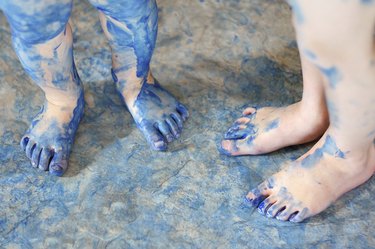
Whether you're painting a house or a model train, a solvent like acetone is great for removing unwanted paint drips and cleaning old brushes. This solvent works very well at removing oil-based paints, enamels and acrylic paint. It can also be reused several times when stored properly. Acetone works equally well on dried and fresh paint. Often, it is the only solvent available to dissolve and remove these types of dried paints.
Things You'll Need
Video of the Day
- Rubber gloves
- Safety Glasses
- Metal or glass containers
- Acetone
- Newspaper
- Clean rags
- Soap
- Water
Video of the Day
Cleaning Paint From a Brush
1. Remove as much paint as possible
Remove as much paint as possible with regular soap and water. If the paint has already dried, large flecks may not be possible to remove with soap.
2. Put on the protective gloves and safety glasses
Put on the protective gloves and safety glasses. This helps keep the acetone off skin and out of the eyes.
3. Pour the acetone into a metal or glass container
Pour the acetone into a metal or glass container. Pour enough into the container that you can easily dip paint-covered bristles into it, but not so much that it reaches the handle.
4. Scrub the bristles against the bottom of the container
Scrub the bristles against the bottom of the container or between gloved fingers. If a large amount of paint is hardened on the bristles, leave the brush in the paint for a couple of hours.
5. Remove as much softened paint as possible
Remove as much softened paint as possible. Dry the brush on old newspaper to absorb remaining acetone.
6. Wash the brush with soapy water again
Wash the brush with soapy water again. Squeeze the water out of the bristles by hand. Shape the brush and set down to dry.
Removing Paint Drips with Acetone
1. Scrape up as much of the paint as possible

Scrape up as much of the paint as possible with a paint scraper. Thick layers of paint may be easier to remove with the scraper.
2. Put on a pair of protective gloves and safety glasses
Put on a pair of protective gloves and safety glasses.
3. Pour a small amount of acetone onto a clean rag
Pour a small amount of acetone onto a clean rag. You may also pour a small amount of acetone onto dried paint. Allow it to sit for a few minutes to soften the paint drip.
4. Rub the paint with the acetone-soaked rag
Rub the paint with the acetone-soaked rag. Within a few minutes, the paint will dissolve. You may need to switch to clean sections of the rag as more paint comes off onto the fabric.
5. Wash the area with clean soap and water
Wash the area with clean soap and water to remove acetone residue.
Warning
Do not store acetone in a plastic container. It can melt plastic over time.